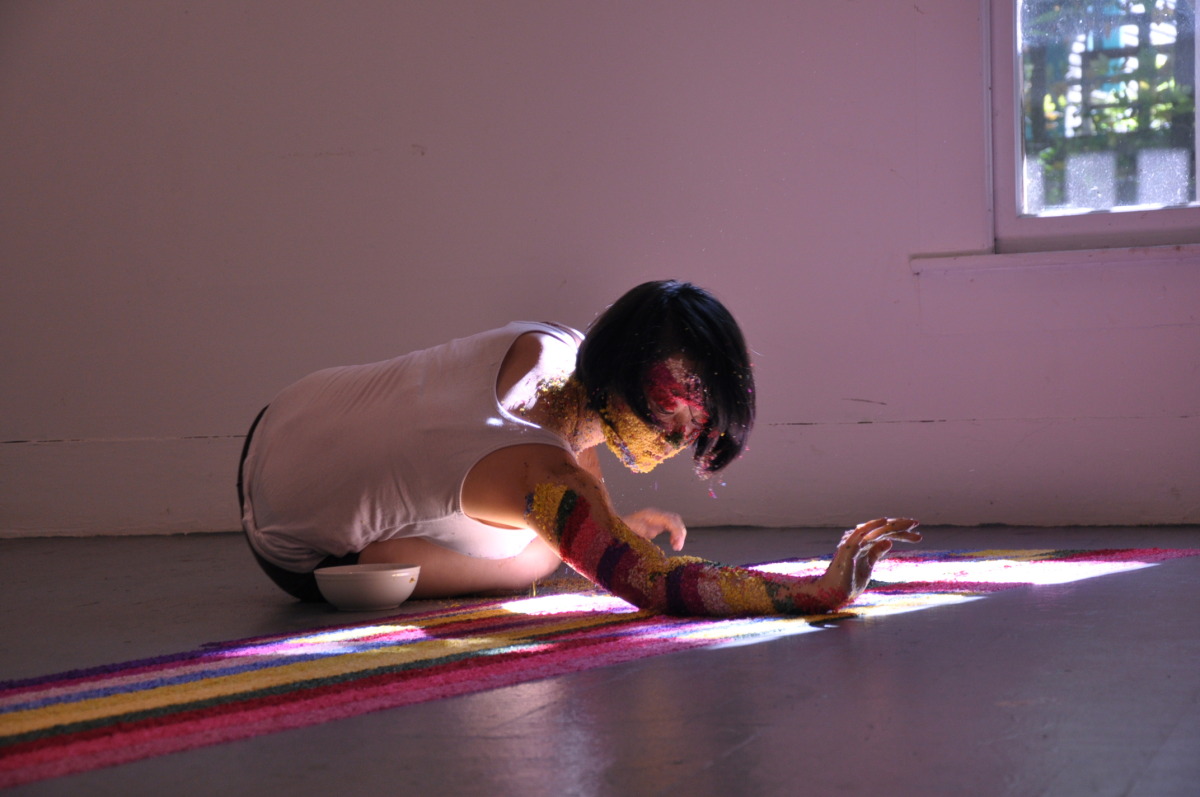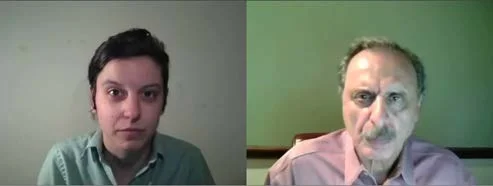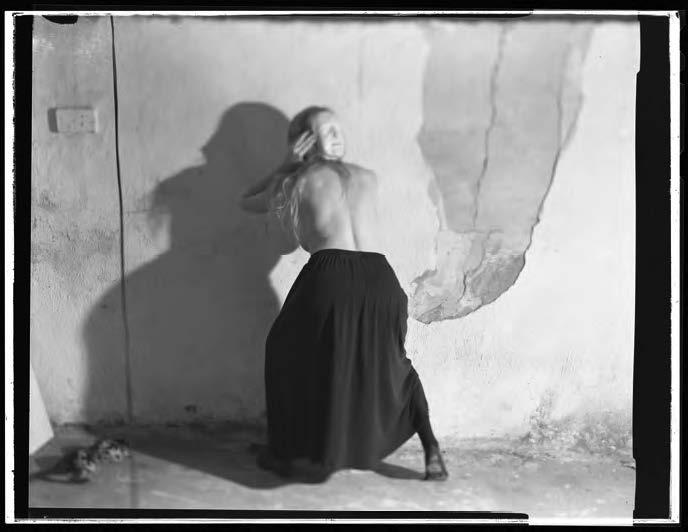2012-14 Housing Residents
Charlie Watts, Masud Olufani, Andre Keichian, and Gyun Hur.
ARTIST STAtements & Porfolios
(click thumbnails to view full size images )
Gyun Hur
When art and life intersect at a pivotal tension point, a dialogue develops in multiple dimensions. The tangibility of symbolically charged materials such as silk flowers acts as an agent of communication in my developing body of work. I have been experimenting with performative installations where improvised rituals and materials converge. I am interested in constructing a visual and psychological space where narratives of labor, loss, and place reside. In my recent installations, a community of people around me and I carefully disassembled and hand-shredded collected silk flowers, then laid them on floor, replicating my mother’s wedding blanket patterns, seck-dong. Specific methodical destruction and labor-intensive reassembly of the silk flowers create an aesthetic happening, turning public or art space into an introspective site of dialogues. My work is at a turning point where my process and materials heavily invested in labor are responding more to the architectural space and interior landscape of emotions. Ephemeral and vulnerable nature of my installations holds unspoken potential of rupture in silence. Through the menial process of making, selective collections of objects transform into a poignant residuum of the past and the present. A sentimental installment of materials and insertion of a physical body facilitate an occupied territory as a platform for opened dialogues, both internal and external.
Andre Keichian
My work addresses topics of identity. I am interested in investigating the complexity of the self through collaborative participation. I am attracted to the dynamic nature of video and film. The intersection of image, sound and movement appropriately speak to the fluidity of identity. I believe these mutable qualities challenge static depictions of the body as object, as any collaborating persons maintain an essential role through their physical participation and engagement. I focus on creating a climate of trust. In part, I establish this through the means of a fixed visual structure, so as to set a physical boundary of safe space and to establish a distance from the camera while shooting. I keep these technical decisions simple and clearly defined as to have the freedom to address and play with the performativity of the work. My aesthetic is deliberate but improvised; everything is only shot once and is unedited. I am dependent on the exchange of participants; it is a balance of having (structural) control while maintaining openness for the unexpected. I am compelled by the idea that I can never truly predict the outcome of any particular piece. This creates a neutrality of power and interdependence between artist and participant, and artist as participant. In this sense, the documented outcome speaks not only to the expression within the moment, but relies on the relational exchange of those involved. It is about setting up a stage to playfully address that, which is personal and possibly uncomfortable. But it is rooted in something real, something that is mutually desired to capture on film. It is inspired through dialogue, texts, and experiences and performed with or by those who have had similar histories, curiosities and desires for personal expression. It is about trust, acknowledging that though we cannot control our outside influences, we do respect one another and ourselves. This is enacted in the moments when we work together and in the ways in which I speak of or place our work thereafter. My work serves as studies; these videos are part of an ongoing survey. Though they largely address themes of gender and sexuality, I am additionally moving towards the consideration of the role of culture, ethnicity and language within a larger spectrum of community and identity.
Masud Ashley Olufani "MAO"
I am haunted by memories: a tattered blue blanket, shattered glass, a blood stained carpet, the distressing finality of a door slammed shut—the absence that follows. I am haunted by sounds: the high pitch of a mother’s cries, the jarring suddenness of an open hand striking a woman’s face, a squeaking mattress heard through a bedroom door, the voices of Michael Jackson and Stevie Wonder spun from an eight track recorder. I am haunted by smells: the dying embers of an incense stick—frankincense and myrrh, the stench of pissed drenched hallways in New York City Subways, the warm scent of recognition buried deep within the fabric of a father’s suits. What is the nature of memory? Where does it reside, and how do present experiences reflect our lived past? In what rooms of the subconscious do we store our pain and our regret, with the hope that the darkness will enshroud all recollection? I am interested in those hidden spaces—spaces that facilitate a sensory experience that may dislodge an imbedded memory. My work is primarily concerned with creating “visual triggers”—objects that in form and content work to undermine the compartmentalized self. Through the use of encoded language, unconventional materials, personal and collective memory, I attempt to unmask the pathology of imposed forgetting—a pathology deeply entrenched within the American psyche.
Charlie Watts
When I approach my photographic practice, I envision the creation of images not of this world. I seek to use photography as a stepping stone to an unknown realm just past consciousness to the peripheral. During the past year, I have immersed myself in creating new work that embodies the spirit of the late Francesca Woodman. Like Woodman, I have created art that relies heavily on the use of blur, creating painterly, otherworldly photographs and placing femininity in abandoned landscapes. Advancing this mystification of the use of blur in abandoned spaces, I have initiated an allegorical dissemination and surrealist attitude towards photography in my quest to inform new work through remnants that Woodman left behind. The result is a unique aesthetic more closely related to early 20th-century movement of Pictorialism. Current movements in photography are harkening to the past. Both Woodman and I used an industrial camera subverted by the mnemonics of artisanal hands to create photographic art that appears more like dreamscapes than realistic representations. These photographs are quiet, simple pictures that resemble experimental paintings rather than technical amalgamations constructed with calculations, chemicals, and precise executions. Through the use of blur, many of the photographers allude to flight. Many figures in the presentation are not entirely readable in the photographs—making them appear more ghostly than human. The emphasis in my photography brings imagination to fruition and shows a different realm, a visual escape from the mundane to fantasy. As an artist, I create work out of a desire to explore all that goes on in my dreamscapes and to elevate photography to its proper place in the fine arts.














































